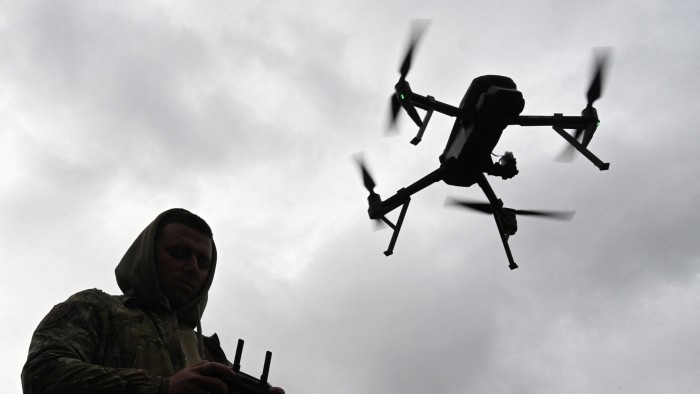Unlock the White House Watch newsletter for free
Your guide to what Trump’s second term means for Washington, business and the world
Nato allies are discussing a more forceful response to Vladimir Putin’s increasingly provocative actions, including by deploying armed drones along the border with Russia and easing restrictions on pilots to allow them to open fire on Russian aircraft.
The talks are aimed at raising the costs for Moscow of its “hybrid warfare” and lay out clear countermeasures after a spate of airspace violations by Russian drones and jets, according to four Nato officials briefed on the talks.
Frontline states bordering Russia, backed by France and the UK, have initiated the discussions, which have since broadened to a larger group in the 32-strong alliance.
Proposals include arming surveillance drones used to collect intelligence on Russian military activities, and lowering the bar for pilots patrolling the eastern border to take down Russian threats. Another option is to conduct Nato military exercises on the border with Russia, especially in more remote and unguarded parts of the frontier.
Donald Trump last month said Nato should open fire on Russian aircraft that breach allied territory.
The US president’s remarks came after a flurry of Russian provocations, including the first direct confrontation between Nato planes and Russian drones since Russia’s full-scale invasion of Ukraine in 2022. In addition to that encounter in Polish airspace, Russian drones have also veered into Romanian territory and MiG fighter jets crossed into Estonian airspace.
Meanwhile dozens of unidentified drones have caused massive disruptions at airports in Belgium, Denmark and Germany, with some officials attributing them to the same hybrid war carried out by Moscow and which includes cyber attacks and sabotage attempts.
Matthew Whittaker, the US ambassador to Nato, said last week that he was “working every single day” with allies to ensure “we have better options on the asymmetrical . . . and hybrid war”. He said it was paramount “to make sure that we have enough rungs on the escalation ladder”.
Two of the Nato officials said that one urgent issue was to streamline the rules of engagement along the eastern flank. Some countries require fighter pilots to make visual confirmation of threats before engaging, while others allow them to open fire based on radar data or the perceived danger from the direction or speed of the hostile object.
Nato did not immediately respond to a request for comment.
The talks, which started out in a small group of directly affected states, have now morphed into a broader discussion, two of the officials said, as other allied capitals recognise the wider threat posed by Moscow’s destabilisation campaign.
Some capitals are also pushing for a more aggressive Nato stance as a means of deterrence, said one of the officials. Other allies are advising a more conservative response, given the risks of direct confrontation with a nuclear power like Russia.
“There are active discussions on these issues, how to better and more efficiently respond to Russia,” said one Nato diplomat, who cautioned that the talks were still in an initial phase.
Nato held emergency talks twice last month, prompted by the incidents in Poland and Estonia, and launched Eastern Sentry — a mission to bolster the air defences of frontline states.
Recommended
There is no timeline or obligation to agree on any change in posture, and a shift may not be publicly communicated, all four officials cautioned.
The Nato discussions come as the EU prepares to take its own steps in response to Russian provocations.
These including curbing the travel around Europe of Russian diplomats, who are suspected by intelligence agencies of running agents and sabotage operations in countries other than where they are officially posted, and using EU funding to help put in place anti-drone defence systems.
“This is a deliberate and targeted grey zone campaign against Europe. And Europe must respond,” European Commission president Ursula von der Leyen said on Wednesday.
“Russia wants to sow division. We have to answer with unity,” she told the European parliament. “We must not only react, we must deter. Because if we hesitate to act, the grey zone will only expand.”

